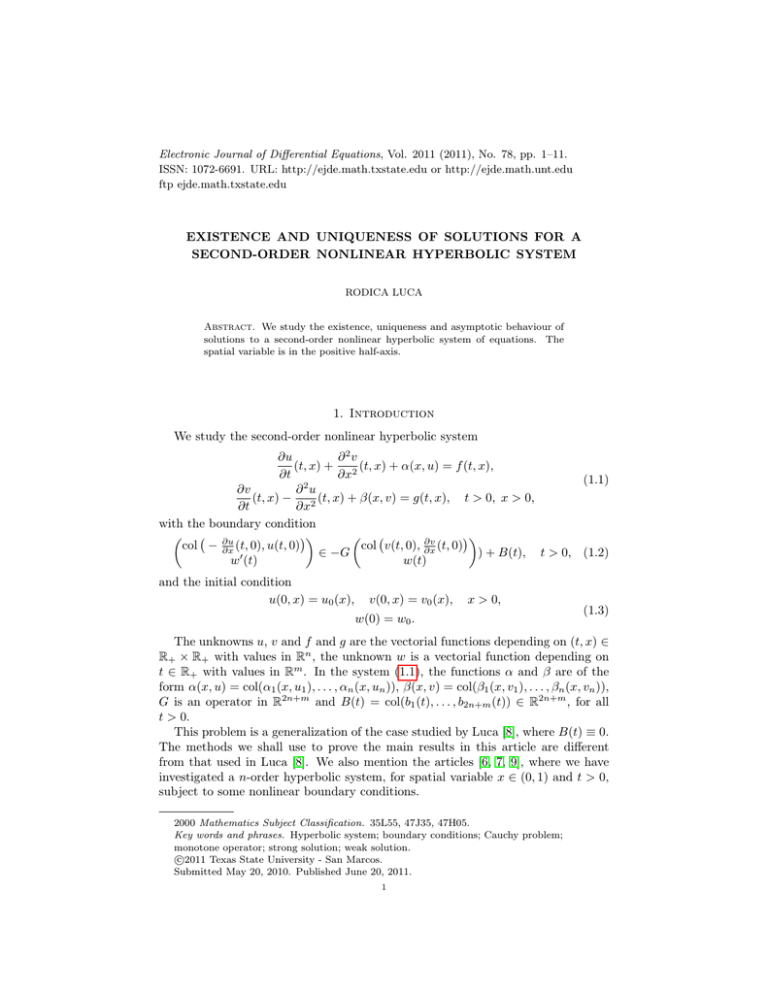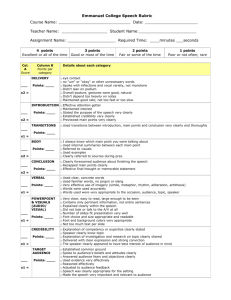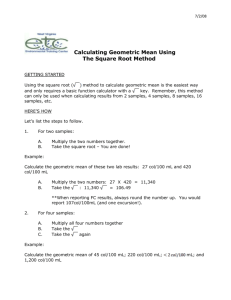Electronic Journal of Differential Equations, Vol. 2011 (2011), No. 78,... ISSN: 1072-6691. URL: or
advertisement

Electronic Journal of Differential Equations, Vol. 2011 (2011), No. 78, pp. 1–11.
ISSN: 1072-6691. URL: http://ejde.math.txstate.edu or http://ejde.math.unt.edu
ftp ejde.math.txstate.edu
EXISTENCE AND UNIQUENESS OF SOLUTIONS FOR A
SECOND-ORDER NONLINEAR HYPERBOLIC SYSTEM
RODICA LUCA
Abstract. We study the existence, uniqueness and asymptotic behaviour of
solutions to a second-order nonlinear hyperbolic system of equations. The
spatial variable is in the positive half-axis.
1. Introduction
We study the second-order nonlinear hyperbolic system
∂2v
∂u
(t, x) + α(x, u) = f (t, x),
(t, x) +
∂t
∂x2
(1.1)
∂2u
∂v
(t, x) −
(t, x) + β(x, v) = g(t, x), t > 0, x > 0,
∂t
∂x2
with the boundary condition
∂v
col − ∂u
col v(t, 0), ∂x
(t, 0)
∂x (t, 0), u(t, 0)
∈
−G
) + B(t), t > 0, (1.2)
w0 (t)
w(t)
and the initial condition
u(0, x) = u0 (x),
v(0, x) = v0 (x),
x > 0,
w(0) = w0 .
(1.3)
The unknowns u, v and f and g are the vectorial functions depending on (t, x) ∈
R+ × R+ with values in Rn , the unknown w is a vectorial function depending on
t ∈ R+ with values in Rm . In the system (1.1), the functions α and β are of the
form α(x, u) = col(α1 (x, u1 ), . . . , αn (x, un )), β(x, v) = col(β1 (x, v1 ), . . . , βn (x, vn )),
G is an operator in R2n+m and B(t) = col(b1 (t), . . . , b2n+m (t)) ∈ R2n+m , for all
t > 0.
This problem is a generalization of the case studied by Luca [8], where B(t) ≡ 0.
The methods we shall use to prove the main results in this article are different
from that used in Luca [8]. We also mention the articles [6, 7, 9], where we have
investigated a n-order hyperbolic system, for spatial variable x ∈ (0, 1) and t > 0,
subject to some nonlinear boundary conditions.
2000 Mathematics Subject Classification. 35L55, 47J35, 47H05.
Key words and phrases. Hyperbolic system; boundary conditions; Cauchy problem;
monotone operator; strong solution; weak solution.
c
2011
Texas State University - San Marcos.
Submitted May 20, 2010. Published June 20, 2011.
1
2
R. LUCA
EJDE-2011/78
In the present work, we shall prove the existence, uniqueness, some regularity
properties and the asymptotic behaviour of the strong and weak solutions for the
problem (1.1), (1.2), (1.3). For the basic notation, concepts and results in the
theory of monotone operators and nonlinear evolution equations of monotone type
in Hilbert spaces we refer the reader to Barbu [2], Brezis [3], Lakshmikantham et
al [5].
Now we introduce the assumptions to be used in this article.
(A1) (a) The functions x → αk (x, p) and x → βk (x, p) are measurable on R+ ,
for any fixed p ∈ R. Besides, the functions p → αk (x, p) and p → βk (x, p)
are continuous and nondecreasing from R into R, for a.a. x ∈ R+ , k = 1, n.
(b) There exist ak > 0, bk > 0, k = 1, n and the functions c1k , c2k ∈
L2 (R+ ) such that
|αk (x, p)| ≤ ak |p| + c1k (x),
|βk (x, p)| ≤ bk |p| + c2k (x),
for a.a. x ∈ R+ , for all p ∈ R, k = 1, n.
(c) There exist χ1 > 0, χ2 > 0 such that
(αk (x, p1 ) − αk (x, p2 ))(p1 − p2 ) ≥ χ1 (p1 − p2 )2 ,
(βk (x, p1 ) − βk (x, p2 ))(p1 − p2 ) ≥ χ2 (p1 − p2 )2 ,
for a.a. x ∈ R+ , for all p1 , p2 ∈ R, k = 1, n.
(A2) (a) G : D(G) ⊂ R2n+m → R2n+m is a maximal
monotone operator (possiG11 G12
with
bly multivalued). Moreover, G =
G21 G22
G11 : D(G11 ) ⊂ R2n → R2n ,
G12 : D(G12 ) ⊂ Rm → R2n ,
G21 : D(G21 ) ⊂ R2n → Rm ,
G22 : D(G22 ) ⊂ Rm → Rm ,
where
T
G((u1 , . . . , u2n+m ) ) =
G11 ((u1 , . . . , u2n )T ) + G12 ((u2n+1 , . . . , u2n+m )T )
.
G21 ((u1 , . . . , u2n )T ) + G22 ((u2n+1 , . . . , u2n+m )T )
(b) There exists ζ1 > 0 such that for all x, y ∈ D(G), x = col(xa , xb ),
y = col(y a , y b ) ∈ R2n × Rm and for all w1 ∈ G(x), w2 ∈ G(y) we have
hw1 − w2 , x − yiR2n+m ≥ ζ1 kxb − y b k2Rm .
(c) There exists ζ2 > 0 such that for all x, y ∈ D(G) and for all w1 ∈
G(x), w2 ∈ G(y) we have
hw1 − w2 , x − yiR2n+m ≥ ζ2 kx − yk2R2n+m .
The operator G is a generalization of the matrix case. It also covers some
general boundary conditions for (1.1). For example, if G12 = 0 and G21 = 0,
then the boundary condition (1.2) becomes
col(−ux (t, 0), u(t, 0)) ∈ −G11 (col(v(t, 0), vx (t, 0))) + B1 (t),
0
w (t) ∈ −G22 (w(t)) + B2 (t),
(1.4)
(1.5)
where B(t) = col(B1 (t), B2 (t)).
The condition (1.5) with (1.3) give us, by integration, the function w. For (1.4),
by making suitable choices of G11 , we deduce many classical boundary conditions.
Here are some examples in the case G11 = ∂l, the subdifferential of l : R2n →
(−∞, +∞]:
EJDE-2011/78
EXISTENCE AND UNIQUENESS OF SOLUTIONS
3
(a) If
(
0,
if u = a, v = b
u
l
=
v
+∞, otherwise.
then (1.4) becomes v(t, 0)(= a, vx (t, 0) = b.
bv, if u = a
u
(b) For n = 1 and l
=
we obtain u(t, 0) = B2 (t) − b,
v
∞, otherwise,
v(t, 0) = a.
(
au, if v = b
u
we obtain ux (t, 0) = −B1 (t) + a,
(c) For n = 1 and l
=
v
∞, otherwise,
vx (t, 0) = b.
u
(d) For n = 1 and l
= au + bv, then (1.4) becomes ux (t, 0) = −B1 (t) + a,
v
u(t, 0) = B2 (t) − b.
2. Preliminary results
Firstly we consider the case B(t) ≡ b0 (a constant vector). In this situation, we
e defined by Gw
e = Gw − b0 , which is under the assumption
can replace G by G,
(A2)a, a maximal monotone operator. So, we suppose without loss of generality
that B(t) ≡ 0. In what follows, we shall recall some results from Luca [8] relating to the existence and uniqueness of the solutions of our problem (1.1), (1.2),
(1.3). We consider the spaces X = (L2 (R+ ; Rn ))2 , Rm and Y = X × Rm with the
corresponding scalar products
g
f1
, g = 1 ∈ X,
hf, giX = hf1 , g1 iL2 (R+ ;Rn ) + hf2 , g2 iL2 (R+ ;Rn ) , f =
g2
f2
m
X
hx, yiRm =
xi yi , x, y ∈ Rm ,
i=1
f
g ,
= hf, giX + hx, yiRm ,
x
y Y
f
,
x
g
∈ Y.
y
We define the operator A : D(A) ⊂ Y → Y ,
D(A) = {y ∈ Y, y = col(u, v, w); u, v ∈ H 2 (R+ ; Rn ), w ∈ Rm ,
col(γ0 v, w) ∈ D(G), γ1 u ∈ −G11 (γ0 v) − G12 (w)},
where γ0 v = col(v(0), v 0 (0)), γ1 u = col(−u0 (0), u(0)),
u
v 00
u
, v ∈ D(A).
−u00
A v =
w
w
G21 (γ0 v) + G22 (w)
We also define the operator B : D(B) ⊂ Y → Y ,
B(y) = col(α(·, u), β(·, v), 0), D(B) = {y ∈ Y, y = col(u, v, w); B(y) ∈ Y }.
Under assumption (A2)a, we have D(A) 6= ∅, D(A) = X × D(G12 ) ∩ D(G22 ) and,
under the assumptions (A1)ab, we obtain D(B) = Y .
Lemma 2.1. If (A2)a holds, then the operator A is maximal monotone.
Lemma 2.2. If (A1)ab hold, then the operator B is maximal monotone.
4
R. LUCA
EJDE-2011/78
Remark 2.3. By Lemma 2.1, Lemma 2.2 and Rockafellar’s theorem (see Barbu
[2, Theorem 1.7, Chapter II]), it follows that, under the assumptions (A1)ab and
(A2)a, the operator A + B : D(A) ⊂ Y → Y is maximal monotone in the space Y .
Using the operators A and B, our problem (1.1), (1.2), (1.3) can be equivalently
expressed as the following Cauchy problem in the space Y
dy
(t) + A(y(t)) + B((y(t)) 3 F (t, ·), , t > 0,
dt
(2.1)
y(0) = y0 ,
where y(t) = col(u(t), v(t), w(t)), F (t, ·) = col(f (t, ·), g(t, ·), 0), y0 = col(u0 , v0 , w0 ).
Lemma 2.4. Assume that (A1)ab, (A2)a hold. If f, g ∈ W 1,1 (0, T ; L2 (R+ ; Rn ))
(with T > 0 fixed), u0 , v0 ∈ H 2 (R+ ; Rn ), col(γ0 v0 , w0 ) ∈ D(G), γ1 u0 belongs to
−G11 (γ0 v0 ) − G12 (w0 ), then problem (1.1), (1.2), (1.3) has a unique strong solution
col(u, v, w) ∈ W 1,∞ (0, T ; Y ). Moreover u, v ∈ L∞ (0, T ; H 2 (R+ ; Rn )).
Remark 2.5. For all t ∈ [0, T ), the above functions u(t, ·), v(t, ·) satisfy the system
(1.1) for a.a. x ∈ R+ (with ∂ + u/∂t, ∂ + v/∂t instead of ∂u/∂t, ∂v/∂t), and together
with w(t) verify the boundary condition (1.2) (with d+ w/dt instead of dw/dt) and
the initial data (1.3).
Lemma 2.6. Assume that (A1)ab, (A2)a hold. If f, g ∈ L1 (0, T ; L2 (R+ ; Rn )) (with
T > 0 fixed), u0 , v0 ∈ L2 (R+ ; Rn ), w0 ∈ D(G12 ) ∩ D(G22 ) then the problem (1.1),
(1.2), (1.3) has a unique weak solution col(u, v, w) ∈ C([0, T ]; Y ).
For the proofs of Lemmas 2.1–2.6 see Luca [8].
In what follows we shall present an existence result for the stationary problem
associated to (2.1).
Lemma 2.7. If (A1)abc, (A2)ab hold, then the stationary problem
A(y) + B(y) 3 0
(2.2)
has a unique solution y = col(u, v, w) ∈ D(A).
Proof. By Remark 2.3, the operator A + B is maximal monotone in Y . In addition,
it is strongly monotone. Indeed, for all y = col(u, v, w), ye = col(e
u, ve, w)
e ∈ D(A),
e
h ∈ (A + B)(y), h ∈ (A + B)(e
y ) we have
hh − e
h, y − yeiY
= hg − ge, z − zeiR2n+m +
n Z
X
k=1
+
n Z
X
k=1
0
0
∞
[αk (x, uk (x)) − αk (x, u
ek (x))][uk (x) − u
ek (x)]dx
∞
[βk (x, vk (x)) − βk (x, vek (x))][vk (x) − vek (x)]dx
e 2Rm +
≥ ζ1 kw − wk
n
X
k=1
χ1 kuk − u
ek k2L2 (R+ ) +
n
X
χ2 kvk − vek k2L2 (R+ )
k=1
≥ χ0 ky − yek2Y ,
where z = col(γ0 v, w), ze = col(γ0 ve, w),
e g ∈ G(z), ge ∈ G(e
z ) and
χ0 = min{χ1 , χ2 , ζ1 /si , , i = 1, m}.
EJDE-2011/78
EXISTENCE AND UNIQUENESS OF SOLUTIONS
5
Therefore, this operator is coercive and then R(A + B) = Y . So we deduce that
equation (2.2) has a unique solution y = col(u, v, w) ∈ D(A).
Now using Remark 2.3, Lemma 2.6, Lemma 2.7 and Brezis [3, Theorem 3.9], we
deduce the following result.
Lemma 2.8. Assume that (A1)abc, (A2)ab hold, f, g ∈ L1loc (R+ ; L2 (R+ ; Rn )) verify the conditions limt→∞ f (t) = f 0 , limt→∞ g(t) = g 0 , strongly in L2 (R+ ; Rn ),
and δ = col(p, q, r) is the unique solution of equation (2.2). Then limt→∞ y(t) = δ,
strongly in Y , where y(t) = col(u(t), v(t), w(t)), t ≥ 0 is an arbitrary weak solution
of equation (2.1)1 . More precisely
Z t
ky(t) − δkY ≤ e−χ0 t ky(0) − δkY +
eχ0 (s−t) kF (s) − F 0 kY ds, t ≥ 0,
0
0
0
0
where F = col(f , g , 0).
d+ y
1
If dF
dt ∈ L (R+ ; Y ) and y(0) ∈ D(A) then limt→∞ k dt (t)kY = 0 strongly in Y
and
Z ∞
Z ∞ +
1
dF
1
d y
0
k((A + B)(y(0)) − F (0)) kY +
k
(t)kY dt ≤
(t)kY dt.
k
dt
χ
χ
dt
0
0 0
0
3. Existence, uniqueness and asymptotic behaviour of solutions
In the general case B(t) is not constant, we make a change of variables uk =
e
u
ek + u
ek , where
e
u
ek (t, x) = (1 + x)e−x bn+k (t) − xe−x bk (t), k = 1, n.
Our problem (1.1), (1.2), (1.3) can be written as
∂2v
∂e
u
e
(t, x) +
(t, x) + α(x, u
e+u
e(t, x)) = fe(t, x),
∂t
∂x2
∂2u
e
∂v
(t, x) + β(x, v) = ge(t, x), t > 0, x > 0,
(t, x) −
∂t
∂x2
with the boundary condition
∂ ue
v(t, 0)
0
− ∂x (t, 0)
∂v
u
(t, 0) + 0 , t > 0,
e(t, 0) ∈ −G ∂x
0
B2 (t)
w(t)
w (t)
(3.1)
(3.2)
and the initial data
u
e(0, x) = u
e0 (x),
v(0, x) = v0 (x),
x > 0,
(3.3)
w(0) = w0 ,
where
e
∂u
ek
fek (t, x) = fk (t, x) −
(t, x) = fk (t, x) − (1 + x)e−x b0n+k (t) + xe−x b0k (t),
∂t
e
∂2u
ek
(t, x) = gk (t, x) + (x − 1)e−x bn+k (t) − (x − 2)e−x bk (t),
gek (t, x) = gk (t, x) +
∂x2
x > 0, t > 0, k = 1, n,
u
ek0 (x) = uk0 (x) − (1 + x)e−x bn+k (0) + xe−x bk (0),
B2 (t) = col(b2n+1 (t), . . . , b2n+m (t)).
x > 0,
k = 1, n,
6
R. LUCA
EJDE-2011/78
Using the operators A and B, the problem (3.1), (3.2), (3.3) can be equivalently
formulated as a time dependent Cauchy problem in the space Y ,
e
u
e
u
e
fe(t, ·)
u
e+u
e(t)
d
3 ge(t, ·)
v + A v + B v
dt
w
w
B2 (t)
w
(3.4)
u
e(0)
u
e0
v(0) = v0 ,
w(0)
w0
where fe = col(fe1 , . . . , fen ), ge = col(e
g1 , . . . , gen ), u
e0 = col(e
u10 , . . . , u
en0 ).
Theorem 3.1. Assume that (A1)ab, (A2)ac hold, f, g ∈ W 1,1 (0, T ; L2 (R+ ; Rn ))
(T > 0 fixed), bk ∈ W 1,2 (0, T ), k = 1, 2n + m, u0 , v0 ∈ H 2 (R+ ; Rn ), w0 ∈ Rm ,
col(γ0 v0 , w0 ) ∈ D(G) and B1 (0) ∈ γ1 u0 + G11 (γ0 v0 ) + G12 (w0 ). Then problem (3.4) (equivalently problem (3.1), (3.2), (3.3)) has a unique strong solution
col(u, v, w) ∈ W 1,∞ (0, T ; Y ). Moreover u, v ∈ L∞ (0, T ; H 2 (R+ ; Rn )), (B1 (t) =
col(b1 (t), . . . , b2n (t))).
Proof. We shall use some similar techniques as those used in Luca [9]. We assume
in a first stage that f, g ∈ W 1,∞ (0, T ; L2 (R+ ; Rn )), bk ∈ W 2,∞ (0, T ), k = 1, 2n,
bj ∈ W 1,∞ (0, T ), j = 2n + 1, 2n + m, and the functions αk (x, ·), k = 1, n are
Lipschitz continuous with Lipschitz constant L independent of x. We consider the
operators C(t), t ∈ [0, T ], defined by D(C(t)) = D(A) and
e
u
e
u
e
u
e
fe(t, ·)
u
e+u
e(t)
− ge(t, ·) , v ∈ D(A).
C(t) v = A v + B v
w
w
w
B2 (t)
w
Using Remark 2.3, we deduce that the operators C(t), t ∈ [0, T ] are maximal
monotone in Y . By the above assumption on the functions αk , k = 1, n, we have
e
e
|αk (x, u
ek + u
ek (t, x)) − αk (x, u
ek + u
ek (s, x))|
e
e
≤ L|u
ek (t, x) − u
ek (s, x)|
≤ L[(1 + x)e−x |bn+k (t) − bn+k (s)| + xe−x |bk (t) − bk (s)|],
for all t, s ∈ [0, T ] for almost all x > 0, k = 1, n. Therefore, we deduce
e
e
kαk (·, u
ek + u
ek (t, ·)) − αk (·, u
ek + u
ek (s, ·))k2L2 (R+ )
Z ∞
Z
≤ 2L2 |bn+k (t) − bn+k (s)|2
(1 + x)2 e−2x dx + 2L2 |bk (t) − bk (s)|2
0
=
5L2
L2
|bn+k (t) − bn+k (s)|2 +
|bk (t) − bk (s)|2 ,
2
2
∞
x2 e−2x dx
0
∀t, s ∈ [0, T ], k = 1, n.
(3.5)
On the other hand for the functions fek , k = 1, n we obtain the inequality
|fek (t, x) − fek (s, x)| ≤ |fk (t, x) − fk (s, x)| + (1 + x)e−x |b0n+k (t) − b0n+k (s)|
+ xe−x |b0k (t) − b0k (s)|,
∀t, s ∈ [0, T ], x > 0, k = 1, n,
EJDE-2011/78
EXISTENCE AND UNIQUENESS OF SOLUTIONS
7
and so
kfek (t, ·) − fek (s, ·)k2 2
≤ 3kfk (t, ·) − fk (s, ·)k2L2 (R+ )
15
3
+ |b0n+k (t) − b0n+k (s)|2 + |b0k (t) − b0k (s)|2 ,
4
4
for all t, s ∈ [0, T ], k = 1, n. For the functions gek , k = 1, n we deduce
L (R+ )
(3.6)
|e
gk (t, x) − gek (s, x)| ≤ |gk (t, x) − gk (s, x)| + |x − 1|e−x |bn+k (t) − bn+k (s)|
+ |x − 2|e−x |bk (t) − bk (s)|,
∀t, s ∈ [0, T ], x > 0, k = 1, n,
and so
3
ke
gk (t, ·) − gek (s, ·)k2L2 (R+ ) ≤ 3kgk (t, ·) − gk (s, ·)k2L2 (R+ ) + |bn+k (t) − bn+k (s)|2
4
15
+ |bk (t) − bk (s)|2 , ∀t, s ∈ [0, T ], k = 1, n.
4
(3.7)
Therefore, we obtain the following inequality for the operators C(t),
kht − hs kY
e
e
≤ kα(·, u
e+u
e(t, ·)) − α(·, u
e+u
e(s, ·))kL2 (R+ ;Rn ) + kfe(t, ·) − fe(s, ·)kL2 (R+ ;Rn )
+ ke
g (t, ·) − ge(s, ·)kL2 (R+ ;Rn ) + kB2 (t) − B2 (s)kRm ,
for all t, s ∈ [0, T ], all ye = col(e
u, v, w) ∈ D(A), all ht ∈ C(t)(e
y ), all hs ∈ C(s)(e
y ).
Using now the relations (3.5)–(3.7) and the assumptions on the functions f, g, bk ,
k = 1, 2n + m, from the last inequality we deduce that there exists L1 > 0 such
that
kht − hs kY ≤ L1 |t − s|,
∀t, s ∈ [0, T ], ∀e
y ∈ D(A), ∀ht ∈ C(t)(e
y ), hs ∈ C(s)(e
y ).
Therefore, the operator family {C(t); t ∈ [0, T ]} verifies the conditions of Kato’s
Theorem (see Kato [4]). By the assumptions of our theorem, we deduce that ye0 =
col(e
u0 , v0 , w0 ) ∈ D(A). It follows that the problem (3.4) has a unique strong
solution ye = col(e
u, v, w) ∈ W 1,∞ (0, T ; Y ), col(e
u(t), v(t), w(t)) ∈ D(A), for all t ∈
[0, T ]. Moreover ye is everywhere differentiable from right on [0, T ) and
e
e(t, ·)
u
e(t)
u
e(t)
f
u
e
(t)
+
u
e
(t)
+
d
v(t) + A v(t) + B v(t) 3 ge(t, ·)
dt
w(t)
w(t)
B2 (t)
w(t)
u
e(0)
u
e0
v(0) = v0 .
w(0)
w0
Hence y(t) = col(u(t), v(t), w(t)) solves the problem
d+ y
(t) + A(y(t)) + B(y(t)) 3 F1 (t, ·), 0 ≤ t < T, in Y
dt
γ1 u(t) ∈ −G11 (γ0 v(t)) − G12 (w(t)) + B1 (t), 0 ≤ t < T
y(0) = y0 ,
where F1 (t, ·) = col(f (t, ·), g(t, ·), B2 (t)). We deduce that y = col(u, v, w) is a
solution of the problem (1.1), (1.2), (1.3).
In a second stage, we suppose that αk (x, ·), k = 1, n are not Lipschitz continuous
and we replace the functions αk (x, ·) by the Yosida approximations αkλ (x, ·), k =
8
R. LUCA
EJDE-2011/78
1, n, λ > 0. Using the above reasoning, we deduce that the problem (3.4) with αkλ
uλ , v λ , wλ ) ∈ W 1,∞ (0, T ; Y ). Then
instead of αk has a unique strong solution col(e
λ
λ λ
λ
y = col(u , v , w ) solves the problem
d+ y λ
(t) + A(y λ (t)) + Bλ (y λ (t)) 3 F1 (t, ·), 0 ≤ t < T, in Y
dt
γ1 uλ (t) ∈ −G11 (γ0 v λ (t)) − G12 (wλ (t)) + B1 (t), 0 ≤ t < T
(3.8)
y λ (0) = y0 ,
with
u
col(α1λ (·, u1 ), . . . , αnλ (·, un ))
Bλ v = col(β1 (·, v1 ), . . . , βn (·, vn )) ,
w
0
λ > 0.
We write the first relation in (3.8) for t + h and t, we subtract the relations and we
multiply the obtained relation by y λ (t + h) − y λ (t) in the space Y . We obtain after
some computations
1 d+ λ
ky (t + h) − y λ (t)k2Y + hgt+h − gt , zt+h − zt iR2n+m
2 dt
− hB1 (t + h) − B1 (t), γ0 v λ (t + h) − γ0 v λ (t)iRn
≤ hf (t + h, ·) − f (t, ·), uλ (t + h) − uλ (t)iL2 (R+ ;Rn )
+ hg(t + h, ·) − g(t, ·), v λ (t + h) − v λ (t)iL2 (R+ ;Rn )
+ hB2 (t + h) − B2 (t), wλ (t + h) − wλ (t)iRm ,
where zt = col(γ0 v λ (t), wλ (t)), zt+h = col(γ0 v λ (t + h), wλ (t + h)), gt ∈ G(zt ),
gt+h ∈ G(zt+h ).
Using (A2)c, the above inequality, we obtain
1 d+ λ
ky (t + h) − y λ (t)k2Y + ζ2 kγ0 v λ (t + h) − γ0 v λ (t)k2R2n
2 dt
+ ζ2 kwλ (t + h) − wλ (t)k2Rm
1
≤ kB1 (t + h) − B1 (t)k2R2n + ζ0 kγ0 v λ (t + h) − γ0 v λ (t)k2Rn
ζ0
1
+ kB2 (t + h) − B2 (t)k2Rm + ζ0 kwλ (t + h) − wλ (t)k2Rm
ζ0
+ kF0 (t + h, ·) − F0 (t, ·)kX · ky λ (t + h) − y λ (t)kY ,
for 0 ≤ t < t + h < T , λ > 0, where F0 (t, ·) = col(f (t, ·), g(t, ·)).
When we choose 0 < ζ0 < ζ2 , we obtain
1 d+ λ
ky (t + h) − y λ (t)k2Y
2 dt
1
≤ kB(t + h) − B(t)k2R2n+m + kF0 (t + h, ·) − F0 (t, ·)kX · ky λ (t + h) − y λ (t)kY ,
ζ0
for 0 ≤ t < t + h < T , λ > 0. We integrate the above inequality over [0, t] and we
deduce that
1 λ
ky (t + h) − y λ (t)k2Y
2
EJDE-2011/78
≤
EXISTENCE AND UNIQUENESS OF SOLUTIONS
9
Z
2 T
1 λ
ky (h) − y λ (0)k2Y +
kB(s + h) − B(s)k2R2n+m ds
2
ζ0 0
Z t
+
kF0 (s + h, ·) − F0 (s, ·)kX · ky λ (s + h) − y λ (s)kY ds,
0
for 0 ≤ t < t + h < T , λ > 0. Using a variant of Gronwal’s lemma, we obtain
ky λ (t + h) − y λ (t)kY
r Z T
1/2
2
kB(s + h) − B(s)k2R2n+m ds
≤ ky λ (h) − y λ (0)kY +
ζ0 0
Z t
+
kF0 (s + h, ·) − F0 (s, ·)kX ds, 0 ≤ t < t + h < T, λ > 0.
0
We deduce from the above inequality that
r Z T
1/2
dB
d+ y λ
2
d+ y λ
k
(t)kY ≤ k
(0)kY +
(s)k2R2n+m ds
k
dt
dt
ζ0 0
ds
(3.9)
Z T
Z T
dg
df
k (s, ·)kL2 (R+ ;Rn ) ds,
+
k (s, ·)kL2 (R+ ;Rn ) ds +
ds
ds
0
0
d+ yλ
for 0 ≤ t < T , λ > 0. Because sup k dt (0)kY ; λ > 0 is a positive constant
independent of λ, using the assumptions of the theorem, the inequality (3.9) gives
us
dy λ
sup k
(t)kY ; λ > 0, 0 < t < T ≤ const.
dt
and then sup{ky λ (t)kY ; λ > 0, 0 < t < T } ≤ const. Hence
{uλ ; λ > 0}, {v λ ; λ > 0} are bounded in L∞ (0, T ; L2 (R+ ; Rn )),
{wλ ; λ > 0} is bounded in L∞ (0, T ; Rm ),
and, using the assumption (A1)b, we deduce that
{Bλ (y λ (t)); λ > 0} is bounded in L∞ (0, T ; Y ).
(3.10)
By (3.8), we have
1 d λ
ky (t) − y µ (t)k2Y ≤ −hBλ (y λ (t)) − Bµ (y µ (t)), y λ (t) − y µ (t)iY ,
(3.11)
2 dt
for 0 < t < T , λ > 0. Using now the relations (3.10) and (3.11), we obtain
ky λ (t) − y µ (t)kY ≤ const.(λ + µ)1/2 ,
0 ≤ t ≤ T, λ, µ > 0.
Therefore, the sequence {y λ ; λ > 0} converges to some function y = col(u, v, w)
in C([0, T ]; Y ) as λ → 0. Using Lebesgue’s Dominated Convergence Theorem, we
obtain Bλ (y λ ) → B(y), as λ → 0, strongly in L2 (0, T ; Y ). By letting λ → 0 in (3.8),
A and G being demi-closed operators, we obtain that y is a strong solution of the
problem (1.1), (1.2), (1.3).
In the third stage (general case), we approximate f, g ∈ W 1,1 (0, T ; L2 (R+ ; Rn ))
by {f j }j≥1 , {g j }j≥1 ⊂ W 1,∞ (0, T ; L2 (R+ ; Rn )) in W 1,1 (0, T ; L2 (R+ ; Rn )), and bk ∈
W 1,2 (0, T ) by {bjk }j≥1 ⊂ W 2,∞ (0, T ), k = 1, 2n, bi ∈ W 1,2 (0, T ) by {bji }j≥1 ⊂
W 1,∞ (0, T ), i = 2n + 1, 2n + m, in W 1,2 (0, T ).
u0 , v0 , w0 ) ∈ D(A), we deduce
Fixing y0 = col(u0 , v0 , w0 ) ∈ Y with ye0 = col(e
after some considerations (see also Luca [9]) that the sequence of the corresponding
10
R. LUCA
EJDE-2011/78
strong solutions {y j = col(uj , v j , wj )}j≥1 converges as j → ∞ to y = col(u, v, w),
which is a strong solution of our problem.
By system (1.1), we deduce uxx , vxx ∈ L∞ (0, T ; L2 (R+ ; Rn )) and, using the
inequality
kz 0 kL2 (R+ ) ≤ C(kz 00 kL2 (R+ ) + kzkL2 (R+ ) ),
for z ∈ H 2 (R+ ),
(see Adams [1]), we get that ux , vx ∈ L∞ (0, T ; L2 (R+ ; Rn )). So we obtain u, v ∈
L∞ (0, T ; H 2 (R+ ; Rn )).
Theorem 3.2. Assume that (A1)ab, (A2)ac hold. If f, g ∈ L1 (0, T ; L2 (R+ ; Rn ))
where T is fixed positive value, bk ∈ L2 (0, T ), k = 1, 2n + m, u0 , v0 ∈ L2 (R+ ; Rn ),
w0 ∈ D(G12 ) ∩ D(G22 ), then problem (1.1), (1.2), (1.3) has a unique weak solution
col(u, v, w) ∈ C([0, T ]; Y ).
Proof. By the assumptions of the theorem, it follows that y0 = col(u0 , v0 , w0 ) ∈
D(A). We consider {y0j }j≥1 ⊂ Y such that ye0j ∈ D(A) and y0j → y0 , as j → ∞,
in Y . Also let the sequences {f j }j≥1 , {g j }j≥1 ⊂ W 1,1 (0, T ; L2 (R+ ; Rn )) be such
that f j → f , g j → g, as j → ∞, in L1 (0, T ; L2 (R+ ; Rn )) and the sequences
{bjk }j≥1 ⊂ W 1,2 (0, T ) be such that bjk → bk , as j → ∞, in L2 (0, T ), k = 1, 2n + m.
Then the corresponding strong solutions y j = col(uj , v j , wj ) ∈ W 1,∞ (0, T ; Y ) of
problem (1.1), (1.2), (1.3), given by Theorem 3.1, satisfy the inequality
r Z T
1/2
2
j
j
l
l
kB j (s) − B l (s)k2R2n+m ds
ky (t) − y (t)kY ≤ ky0 − y0 kY +
ζ0 0
Z t
kF0j (s, ·) − F0l (s, ·)k2X ds, 0 ≤ t ≤ T, ∀j, l ∈ N,
+
0
where
F0j
j
j
= col(f , g ), j ≥ 1, which leads us to the conclusion.
Theorem 3.3. Assume that (A1)abc, (A2)ac hold. If f, g ∈ L1loc (R+ ; L2 (R+ ; Rn )),
bk ∈ L2 (R+ ), k = 1, 2n + m such that limt→∞ f (t) = f 0 , limt→∞ g(t) = g 0 ,
strongly in L2 (R+ ; Rn ) and δ = col(p, q, r) is the unique solution of (2.2). Then
limt→∞ y(t) = δ, strongly in Y , where y(t) = col(u(t), v(t), w(t)), t ≥ 0 is an
arbitrary weak solution of (3.4).
Proof. By Lemma 2.7, the operator A + B is strongly monotone and equation (2.2)
has a unique solution δ = col(p, q, r) ∈ D(A). We define for any l ∈ N the function
(
B(t), for 0 ≤ t ≤ l
l
B (t) =
0,
for t > l.
Let y0 = col(u0 , v0 , w0 ) ∈ D(A); we denote by y(t), y l (t), t ≥ 0 the weak solutions of problem (1.1), (1.2), (1.3) corresponding to data {B, f, g, y0 }, respectively
{B l , f, g, y0 }, given by Theorem 3.2. Then we have
Z ∞
1/2
l
kB(s)k2R2n+m ds
, t > l.
(3.12)
ky (t) − y(t)kY ≤ const.
l
l
Because for t > l, y is the weak solution corresponding to B(t) ≡ 0, by Lemma
2.8, we deduce that y l (t) → δ, as t → ∞ in Y , (l ∈ N). Hence this last conclusion
with (3.12) and the inequality
ky(t) − δkY ≤ ky(t) − y l (t)kY + ky l (t) − δkY
EJDE-2011/78
EXISTENCE AND UNIQUENESS OF SOLUTIONS
give us that y(t) → δ, as t → ∞, in Y .
11
Acknowledgments. The author wants to express her gratitude to the anonymous
referee for his/her valuable comments and suggestions.
References
[1] R. A. Adams; Sobolev spaces, Academic Press, New York (1975).
[2] V. Barbu; Nonlinear Semigroups and Differential Equations in Banach Spaces, Noordhoff,
Leyden (1976).
[3] H. Brezis; Operateurs maximaux monotones et semigroupes de contractions dans les espaces
de Hilbert, North-Holland, Amsterdam (1973).
[4] T. Kato; Nonlinear semigroups and evolution equations; J. Math. Soc. Japan, 19 (1967),
508-520.
[5] V. Lakshmikantham, S. Leela; Nonlinear Differential Equations in Abstract Spaces, International Series in Nonlinear Mathematics: Theory, Methods and Applications, Vol.2, Pergamon
Press (1981).
[6] R. Luca; Time periodic solutions for a higher order nonlinear hyperbolic system, Libertas
Math., Vol. XIX (1999), 83-93.
[7] R. Luca; Existence and uniqueness results for a higher order hyperbolic system, Mathematical
Reports (Stud. Cerc. Mat.), Vol. 1(51) (1999), 551-571.
[8] R. Luca; Boundary value problems for a second-order nonlinear hyperbolic system, Comm.
Appl. Anal., 8 (2004), 305-321.
[9] R. Luca; An aymptotic result for the solutions of a higher order hyperbolic problem, PanAmer.
Math. J., 14 (2004), 99-109.
[10] R. Luca; Monotone boundary conditions for a class of nonlinear hyperbolic systems, Intern.
J. Pure Appl. Math., 32, No.1 (2006), 83-103.
Rodica Luca
Department of Mathematics, Gh. Asachi Technical University, 11 Blvd. Carol I, Iasi
700506, Romania
E-mail address: rluca@math.tuiasi.ro








